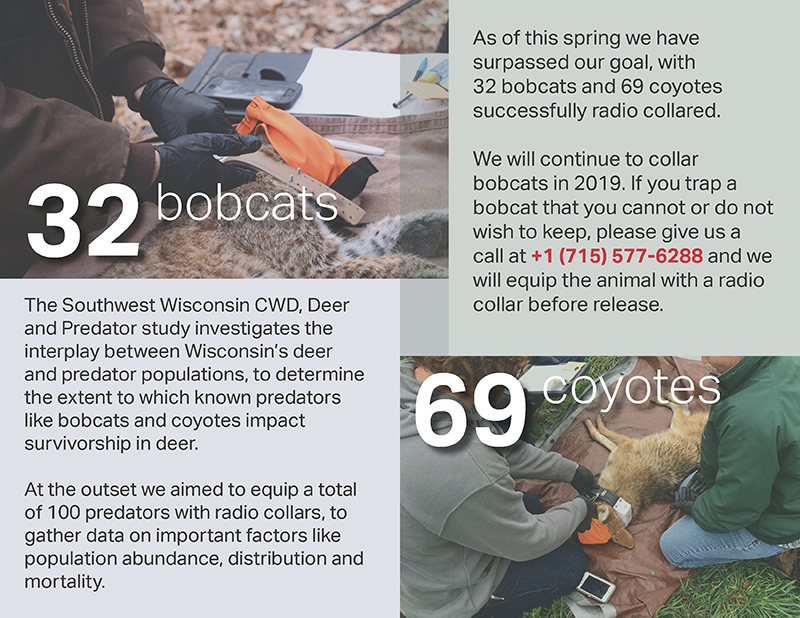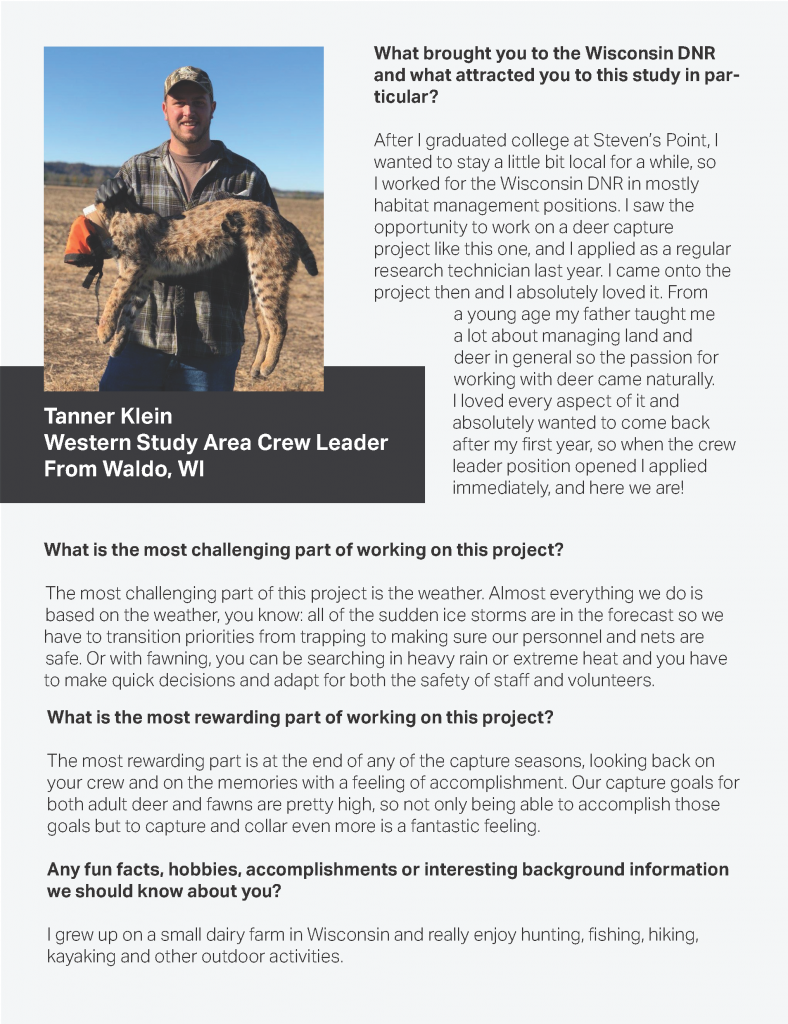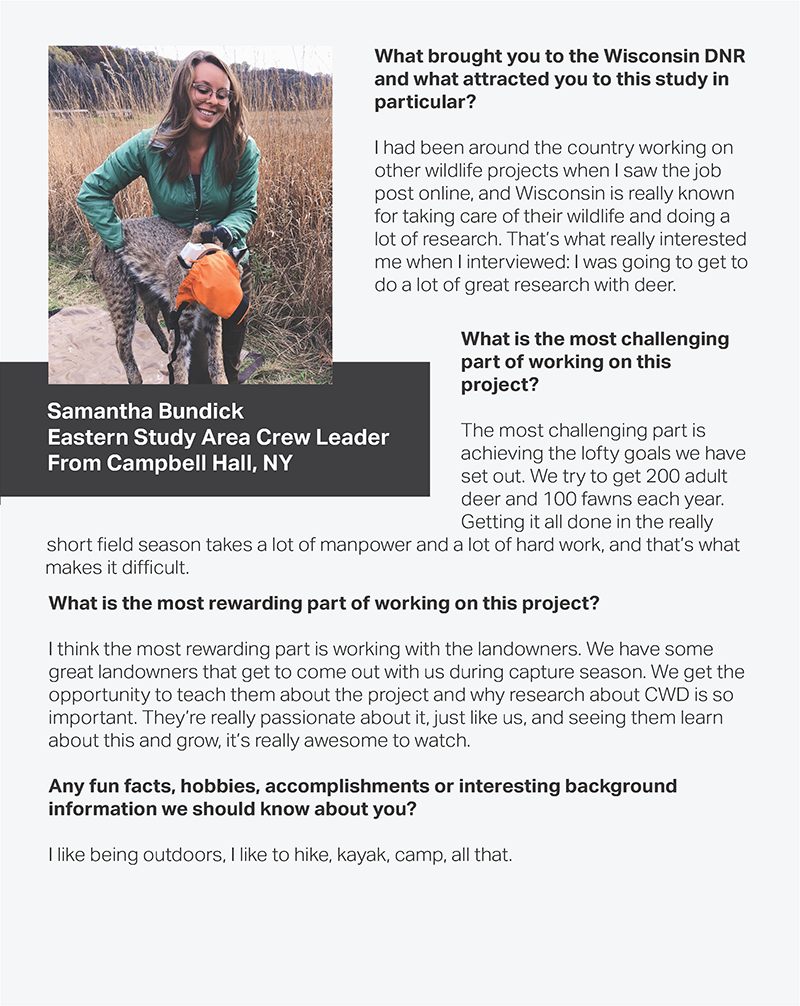Southwest Wisconsin CWD, Deer & Predator Study Newsletter
Issue 10: August 2019
In this issue of Field Notes, we look back on the most successful fawn survey to date and celebrate the incredible effort put forth by both our project staff and our volunteers. We recap the standing count of collared predators and hear from two more staff members, Western and Eastern Study Area Crew Leaders Tanner Klein and Samantha Bundick.
Click the titles below to read this issue’s full articles and view our videos.
Fawn Survey 2019
Our crew collared the most fawns of any season to date, a feat that would not have been possible without the help of our volunteers.
Predator Study Update
We have officially exceeded our goal of collaring 100 carnivores.
Staff Profiles
Crew Leaders Tanner Klein and Samantha Bundick talk to us about their experience in the Southwest CWD, Deer and Predator study and what makes working for the project so rewarding.
Fawn Survey
The consensus from the Southwest Wisconsin CWD, Deer and Predator project crew regarding the 2019 fawn survey was that it ran smoothly – according to Assistant Project Coordinator Dana Jarosinski, by this point in the project the team is practiced and operates like a “well-oiled machine”. This may be something of an understatement; despite some concern at the outset as to whether they would achieve their target of collaring 100 fawns, this season was the most successful to date with a final tally of 128 fawns collared.
“We were a little bit worried about whether or not we were going to be successful because of how the winter was, with the adult deer and the does,” said Dana. “It started off a little bit rocky, we didn’t have as many fawns, but when the peak came around May 26th and 27th like it usually does, we had a string of really successful days and knew that we would easily pass our goal.”
For the most part, conditions were ideal. The mosquitos were reasonable, the weather was cooperative and no accidents or injuries were incurred on the part of the volunteers or the project crew. The survey spanned over 50 private properties in Wisconsin, and the crew excelled behind-the-scenes in coordinating logistics including organizing vehicle transport, acquiring the proper equipment, interacting with landowners and managing the ever-changing roster of DNR personnel who participated in the survey.
In addition to the tireless efforts of the project crew, volunteers donated 1800 hours of labor to the fawn survey. Ranging in age from 8 to 80 years old, their service to our project was crucial in helping us surpass our goal. Crew members reflect fondly on their experience working with volunteers. When asked what he enjoyed most about this year’s survey, Western Study Area Crew Leader Tanner Klein mentioned that the excitement on the part of the volunteers when they see a fawn for the first time is particularly rewarding. “It’s kind of this look of awe on everyone’s face – and we always tell everyone that we can’t guarantee they’ll see one, but when they do see the first one, everyone’s excitement – that really does it for me.”
Project Coordinator Wes Ellarson said that he appreciated the opportunity to offer middle and high-school students hands-on experience in wildlife research. “When you’re working with people that are interested in following this kind of thing in their career path, it’s cool to show them some of their first experiences in the field,” he said.
Among the biggest challenges, Eastern Study Area Crew Leader Samantha Bundick named the pressure to give volunteers a positive experience and to keep spirits up even after long days of searching. However, it is always well worth it when a fawn is discovered: “They’re very charismatic little animals,” said Samantha. “Seeing everyone’s reaction to that is always a ton of fun to watch.”
On the whole, this survey was a tremendous feat executed to fruition thanks to the expertise of the project crew and many hours of hard work from our volunteers. From the Southwest Wisconsin CWD, Deer and Predator Study crew and the Office of Applied Science, we extend our sincere gratitude to those members of the public who took the time to participate in our survey. Your contribution was invaluable and we hope to have you in the field with us next year.
Predator Update
Staff Profiles
We’re pleased to feature in this edition of Field Notes two more exemplary members of our project staff, Tanner Klein and Samantha Bundick.






